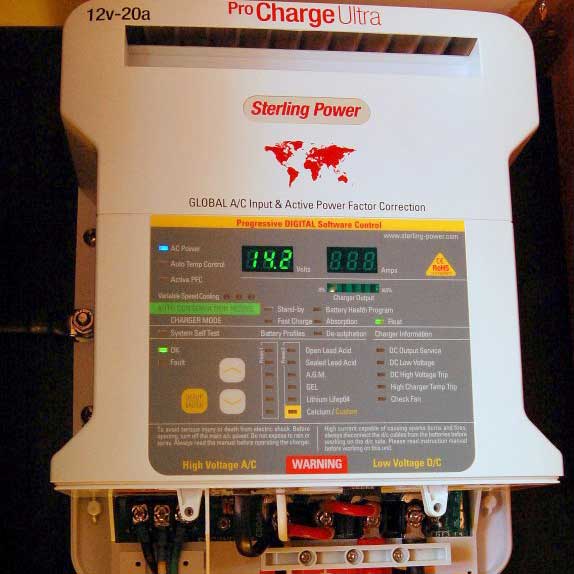Anyone else experiencing issues with Firefly batteries prematurely failing?
In 2019 I started kicking around the idea of installing Firefly G31 batteries in my Hunter 36 to replace aging 4D batteries and after some discussions here in forums I decided to install two of them in parallel for one large house/starting bank. On the advice of MaineSail I upgraded my charging system as well, both the shore charger and replaced the "dumb" original alternator with an 80 amp from Rodd and an external regulator.
Fast forward one year and one of the two Firefly batteries would hold no more than ~40ah, even after a careful restoration charge. The other battery was fine. The bad battery was confirmed as so by the local seller and replaced under warranty. I purchased an additional G31 Firefly and wired the bank or now 3 together in parallel.
Fast forward to fall 2021 and I noticed my bank underperforming noticeably while out on longer trips. I would reach my low voltage warning in my BMS way before I calculated it should be so. I finished the season and brought the batteries home for bench testing and careful restoration charges. Results: One battery is holding ~35 ah after a restoration, the second ~70, and the third restores to slightly more than its expected full capacity. Restoration is done with a 65 amp bench charger that can be manually adjusted for voltage so I can strictly adhere to the manufacturer's restoration charge instructions.
Interestingly, this article articulates almost exactly what I'm experiencing, and they had to have multiple replacements before they got Fireflies that worked as expected: Firefly Woes – Our Next Adventures and then article #3 in their Firefly series that indicated they finally got batteries working as expected Firefly Redeemed – Our Next Adventures .
System setup: Three firefly G31 batteries wired in parallel used as start and house for Hunter 36 sailboat with Yanmar 3YM30 diesel auxiliary. Boat is used occasionally for overnight or multi-day trips, but mostly day trips with shore power left on when at the dock and shore charger left connected to maintain batteries when away from the boat.
Shore charger: Sterling Pro Charge Ultra 60 amp charger set to custom profile for Firefly batteries per battery charge/float instructions in Firefly manual
Alternator: Externally regulated 80a alternator; Wakespeed WS100 regulator set to Firefly charge/float profile (available setting from factory) and field output set to 75%
Solar: One 160 watt panel with Victron MPPT 100/20 controller set to charge/float settings per instructions from Firefly
In 2019 I started kicking around the idea of installing Firefly G31 batteries in my Hunter 36 to replace aging 4D batteries and after some discussions here in forums I decided to install two of them in parallel for one large house/starting bank. On the advice of MaineSail I upgraded my charging system as well, both the shore charger and replaced the "dumb" original alternator with an 80 amp from Rodd and an external regulator.
Fast forward one year and one of the two Firefly batteries would hold no more than ~40ah, even after a careful restoration charge. The other battery was fine. The bad battery was confirmed as so by the local seller and replaced under warranty. I purchased an additional G31 Firefly and wired the bank or now 3 together in parallel.
Fast forward to fall 2021 and I noticed my bank underperforming noticeably while out on longer trips. I would reach my low voltage warning in my BMS way before I calculated it should be so. I finished the season and brought the batteries home for bench testing and careful restoration charges. Results: One battery is holding ~35 ah after a restoration, the second ~70, and the third restores to slightly more than its expected full capacity. Restoration is done with a 65 amp bench charger that can be manually adjusted for voltage so I can strictly adhere to the manufacturer's restoration charge instructions.
Interestingly, this article articulates almost exactly what I'm experiencing, and they had to have multiple replacements before they got Fireflies that worked as expected: Firefly Woes – Our Next Adventures and then article #3 in their Firefly series that indicated they finally got batteries working as expected Firefly Redeemed – Our Next Adventures .
System setup: Three firefly G31 batteries wired in parallel used as start and house for Hunter 36 sailboat with Yanmar 3YM30 diesel auxiliary. Boat is used occasionally for overnight or multi-day trips, but mostly day trips with shore power left on when at the dock and shore charger left connected to maintain batteries when away from the boat.
Shore charger: Sterling Pro Charge Ultra 60 amp charger set to custom profile for Firefly batteries per battery charge/float instructions in Firefly manual
Alternator: Externally regulated 80a alternator; Wakespeed WS100 regulator set to Firefly charge/float profile (available setting from factory) and field output set to 75%
Solar: One 160 watt panel with Victron MPPT 100/20 controller set to charge/float settings per instructions from Firefly


